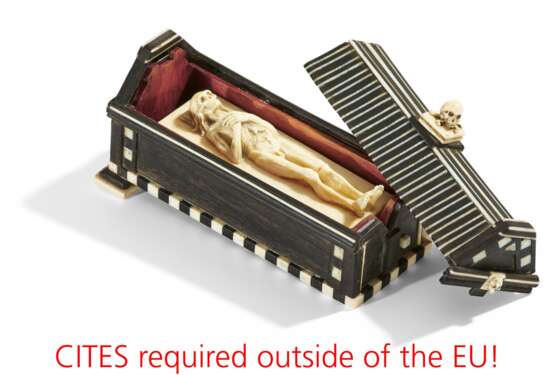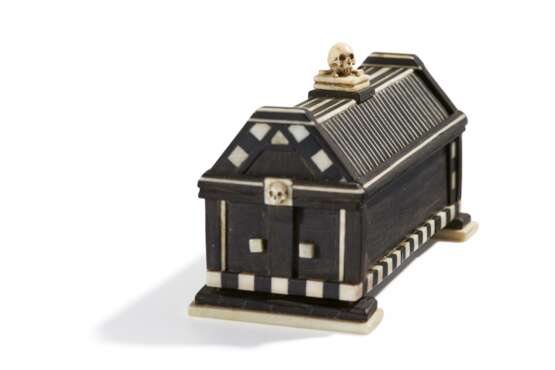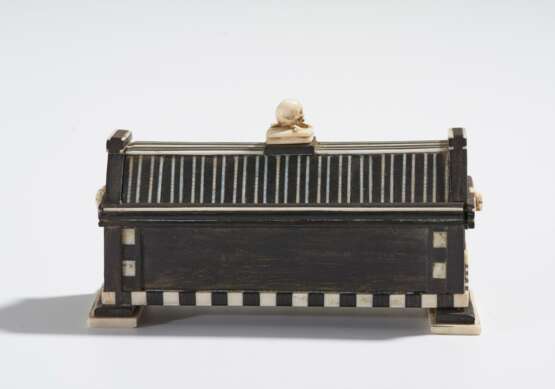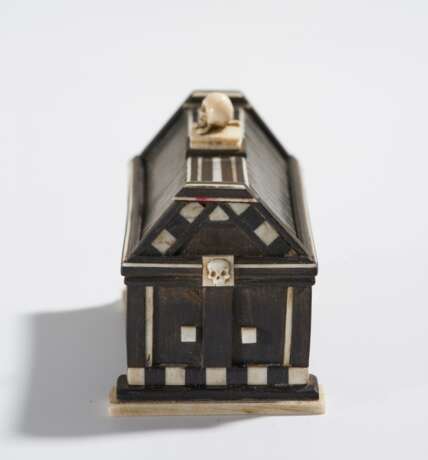ID 647755
Lot 31 | Little dead in coffin with secret mechanism made of ivory, wood and metal
Estimate value
€ 5 000 – 6 000
Date: 17th century.
Technique: Ivory, wood, metal and other materials.
Description: Small rectangular casket in the shape of a coffin. The gable-shaped lid with striped- and
the edges of the body with cube-shaped inlays. On the upper side of the lid a small, fully
plastic skull above crossed bones as well as a small human skull on each of the front
sides. Inside, the already clearly decomposing corpse of a man lying with his arms crossed
in front of his chest. The drastic, realistic depiction is executed with great skill.
Measurement: 4,5x8x3,5cm.
The small coffin casket can only be opened by means of a hidden mechanism and a certain sequence of different actions, which consists of removing or adjusting certain parts. First, a small pin on one of the front sides has to be pulled out in order to be able to remove a small bar on the side. In a subsequent step, the small skull on the lid is turned to the left and so one of the two feet can then be removed and the lid pushed open. The "viewing coffin", which is closed in a very unusual way with the trick mechanism described above, becomes a very special object of meditation on death and the finiteness of everything human through the duration of the opening process.
Memento mori - Remember that you will die!
The discussion of the vanitas idea, the preparation for death and thus for the Last Judgment and the safeguarding of one's own salvation has a long tradition in the German-speaking realm. It is therefore not surprising that the theme has been approached by artists again and again over several centuries.
Our "Tödlein im Sarge" (little death in coffin) fits seamlessly into the tradition of a special genre of devotional objects. In its eeriness it is supposed to remind the beholder of his mortality and to make him aware of the transitoriness of his earthly existence. The small personifications of death are usually ageless, statusless, and genderless, and thus speak to any recipient. Some are skeletonized, some depict the human body in the middle of decay. Very often they are delicate and filigree works made of ivory, which closely resembles the appearance of pale human bones. Tödlein of this type are also known as table or pocket coffins. In addition to their function as meditational objects, they were coveted art and collector's items and were sometimes used by medical amateurs to study anatomy.
| Auction house category: | Early Works of Art |
|---|
| Auction house category: | Early Works of Art |
|---|
| Address of auction |
VAN HAM Kunstauktionen GmbH Hitzelerstr. 2 50968 Köln Germany | ||||||||||||||
|---|---|---|---|---|---|---|---|---|---|---|---|---|---|---|---|
| Preview |
| ||||||||||||||
| Phone | +49 221 92586215 | ||||||||||||||
| Fax | +49 221 92 58 62 4 | ||||||||||||||
| Buyer Premium | 32% | ||||||||||||||
| Conditions of purchase | Conditions of purchase | ||||||||||||||
| Business hours | Business hours
|







